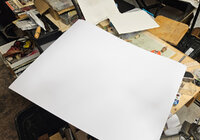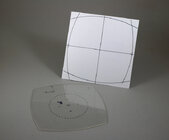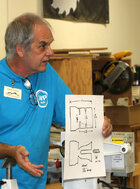Would there be any issue using a car wax on the lathe bed. I see a lot of people using paste wax which SC Johnson apparently does not manufacture anymore.
-
It's time to cast your vote in the June 2025 Turning Challenge. (click here for details) -
Congratulations to John Shannon"Cherry Bowl" being selected as Turning of the Week for June 30 2025 (click here for details) -
Sign up for the 2025 AAW Forum Box Swap by Monday, June 30th (click here for details) -
Welcome new registering member. Your username must be your real First and Last name (for example: John Doe). "Screen names" and "handles" are not allowed and your registration will be deleted if you don't use your real name. Also, do not use all caps nor all lower case.
You are using an out of date browser. It may not display this or other websites correctly.
You should upgrade or use an alternative browser.
You should upgrade or use an alternative browser.
Car wax on lathe bed?
- Thread starter Rob Gabel
- Start date
I use Minwax finishing wax on mine, it's similar to the Johnson paste wax. Some automotive waxes contain silicone which can cause problems with finishing.
I've used car wax on the lathe without any issues, but in my experience, it doesn't work as well as the Johnson did.
I use Microcrystalline Wax on my lathe and not had any issues. I put it on the paintwork as well to help protect it from any accidental spills.
Over here in the UK they sell Machine Wax. I’m not sure exactly what it is but it looks very similar to Microcrystalline wax.
Over here in the UK they sell Machine Wax. I’m not sure exactly what it is but it looks very similar to Microcrystalline wax.
I'd say as long as the auto wax contains no silicone (just a bad idea to have silicone in a wood shop due to problems it causes wood finishes), you'll be fine.
Wax from plants (carnuba), wax from bugs (beeswax), and wax from crude oil (paraffin), take your pick. Anything else they add to the wax is a solvent, or a microabrasive to help polish a surface during wax application. 99.9% of whatever wax you apply to a surface (car hood, coffee table, lathe bed) gets removed as you buff it off properly afterward. Carnuba is the hardest, and highest melting temp, of the 3 general waxes we'd have in our workshops.
Wax from plants (carnuba), wax from bugs (beeswax), and wax from crude oil (paraffin), take your pick. Anything else they add to the wax is a solvent, or a microabrasive to help polish a surface during wax application. 99.9% of whatever wax you apply to a surface (car hood, coffee table, lathe bed) gets removed as you buff it off properly afterward. Carnuba is the hardest, and highest melting temp, of the 3 general waxes we'd have in our workshops.
For a machine that requires resistance tor a sliding part to perform the task, wax is counter intuitive in my opinion. A spritz of WD40 and a wipe down with a Scotchbrite pad is what I have been doing for decades. If you don't plan on using the lathe for a while, let a film of WD40 sit on it. Also decades ago, Ellsworth promoted letting your bed rust for more grip on the tailstock.
I've used automotive wax on the bed to aid in positioning the banjo. However I prefer a bit of Renaissance (microcrystalline) wax - wax on, wax off with a cloth.
I have had zero problems with anything sliding when I didn't want it to slide. My lathe has good clamps.
I have had zero problems with anything sliding when I didn't want it to slide. My lathe has good clamps.
For a machine that requires resistance tor a sliding part to perform the task, wax is counter intuitive in my opinion. A spritz of WD40 and a wipe down with a Scotchbrite pad is what I have been doing for decades. If you don't plan on using the lathe for a while, let a film of WD40 sit on it. Also decades ago, Ellsworth promoted letting your bed rust for more grip on the tailstock.
I periodically apply wax to the lathe bed and on the underside of the banjo and tailstock. This allows the banjo and tail stock to glide nicely on the bed but doesn’t prevent them locking into place as usual.
I sprayed WD40 onto a milling machine table one winter many years ago, mistakenly expecting it to protect it. When I went out into the workshop two weeks later the table was covered in rust. Never again.
Agreed- good clamping, and that doesn't mean overtightening the clamps, have never been bothered by wax application on my old Jet mini, 3 different size Vicmarcs, and a Oneway 1224. Again, 99.9% of the wax is wiped back off. In reality, the wax, WD40, Boeshield, etc. is probably more placebo effect. I think the greater likelyhood is that the metal-on-metal surfaces are clean of sticky tree goo and dirt. Heck, 409 cleaner, Simple Green, etc., and a rag will probably result in improvement of the rest and tailstock movement as much as anything else mentioned here. And I've never done anything to the tables on 2 bandsaws, my former table saw, nor my drill presses. In a climate controlled shop, like mine, rust has never been part of the conversation on any raw cast iron surface. Summer- window AC set at 70, also controls humidity. Winter- 5000 watt (30-amp circuit) electric unit heater hanging from the ceiling maintaining about 63-64. Both benefit from a little 9" fan on the floor at one end blowing up 45 degrees to keep the conditioned air circulating. My shop is single car garage size, a hair over 200sq ft. But I've gone off topic, sorry.I've used automotive wax on the bed to aid in positioning the banjo. However I prefer a bit of Renaissance (microcrystalline) wax - wax on, wax off with a cloth.
I have had zero problems with anything sliding when I didn't want it to slide. My lathe has good clamps.
I use Veritas Tool Wax from Lee Valley. It's a microcrystalline wax designed to reduce friction and prevent corrosion on tools.
I think the greater likelyhood is that the metal-on-metal surfaces are clean of sticky tree goo and dirt.
When I get any finish, glue, gunk on the lathe bed I clean it off with an old cabinet scraper, then rub on a little microcrystalline wax.
Graphite powder on the bedways and banjo shaft about once a month.
Takes only a minute or two.
Apply with a cloth and disposable glove....then toss the glove.
That banjo will slide with one finger!
Try it.....you'll be glad you did!
=o=
Takes only a minute or two.
Apply with a cloth and disposable glove....then toss the glove.
That banjo will slide with one finger!
Try it.....you'll be glad you did!
=o=
Odie, is their any messiness between application cycles of the graphite? Does it continually come off from hand touching or anything else in contact with the bed?
Odie, is their any messiness between application cycles of the graphite? Does it continually come off from hand touching or anything else in contact with the bed?
I haven't had any problems with "messiness" but I never have my hands on the bedways anyway. I'd imagine if you rub your hands on the bedways, you might see some. All I can say is, if a few of you try the graphite, you won't go back to using a paste wax.
Note: I was using a paste wax last century.....until someone else suggested the graphite.....then there was no turning back after that!
=o=
I keep a jar of paraffin dissolved in mineral spirits for protecting cast iron and steel. The formula is simple: dissolve paraffin shavings in mineral spirits until no more will dissolve. An acid brush lives in the jar for small applications and a bit of paper towel spreads a light coat on large surfaces. When the mineral spirits have evaporated from the surface, I wipe down with a clean paper towel. I do not have a problem with the tailstock moving.
All I can say is, if a few of you try the graphite, you won't go back to using a paste wax.
I think I'll try that.
I have a tube of extremely finely powdered graphite with a felt applicator left over from when I rebuilt a player piano action decades ago. (the wooden slides, govenors, some felt, metal-to-wood pivots, and such are often lubricated with graphite - never oil, silicone, etc. Doesn't take much.) Never thought of using it on metal-to-metal contacts.
If not careful it will go everywhere. It does leave a nice, dark, glossy sheen - just now wondering how it would look rubbed on the surface of wood or texture highlights!
JKJ
So, on the subject of waxing or using graphite on the ways. What do all of you guys use to protect the ways from finish and the like? I've used some strips of cardboard, but that gets unruly and problematic rather quickly, and I seem to have run out of cardboard that will do the trick. I usually use a paste wax for my ways, although I might try some graphite as the paste wax doesn't give me one-finger banjo capability, which sounds really nice! (Banjo on the PM3520C is pretty wide and can be a bit unruly to move around just by its locking lever.) However, I find that I all too readily ruin that waxed surface all too quickly when I'm finishing (even when I do have cardboard, keeping it in place over the banjo and between the head and tailstocks, is sometimes a chore, too.)
I seem to have run out of cardboard
I know a possible source of high quality, free, card stock, white on one side, a calendar printed on the other. Our area credit union gives out calendars at the end of every year, two sizes. By March, everyone who wants some has them so I stop in and ask and they give me what's left over. This is card stock, similar to good quality poster board. maybe over 100 weight based on a quick thickness measurement. At the moment I have a lifetime supply.
Last year they gave me a box of 500 sheets of 8.5"x11",
and four boxes of 150 sheets each sheet 22"x28".
(One box of big calendars was 3 years out of date but they hated to just throw them in the trash.)

I use these a LOT. The big pieces are perfect for covering work surfaces when making messes like rebuilding carburetors, tracing outlines, photographing some things, catching finishes and stains, and making templates.
I use the smaller ones on the lathe bed, to sketch out designs and make notes, plan sequences, make smaller templates, and make drawings to hold up at demos. The cardboard is thick enough the calendar printed on the other side doesn't show through if the light behind isn't too bright. I sometimes just buy poster board but I'm getting cheap as I get older.
For my small squarish platters

For a handbell ornament demo, before we had cameras and big video screens!

I started getting this stuff from the bank many years ago when teaching kindergarten SS classes - I'd take pieces for kids to draw and color, cut into shapes.
Some public school teachers would get some for their classes.
Maybe check with your local banks and see if they provide similar calendars. Or check with a printing shop - perhaps they have a stack of misprints destined for the dump.
JKJ
I didn't know we were talking about seasonal protection on the lathe bed. WD40 is definitely not good for that. Actually a piece of cardboard works great for that since the condensation will not collect on the cast iron when it is covered.I periodically apply wax to the lathe bed and on the underside of the banjo and tailstock. This allows the banjo and tail stock to glide nicely on the bed but doesn’t prevent them locking into place as usual.
I sprayed WD40 onto a milling machine table one winter many years ago, mistakenly expecting it to protect it. When I went out into the workshop two weeks later the table was covered in rust. Never again.
I'm not a fan if WD40 for any purpose. I bet I haven't owned a can in over 20 years. It's a sub-par lubricant, if at all. Water Displacement, version #40.I didn't know we were talking about seasonal protection on the lathe bed. WD40 is definitely not good for that. Actually a piece of cardboard works great for that since the condensation will not collect on the cast iron when it is covered.
I do have a can of wd40. It works well for removing tape glue off of appliances that have had tape stuck to them. Other than that, it's not very useful.I'm not a fan if WD40 for any purpose. I bet I haven't owned a can in over 20 years. It's a sub-par lubricant, if at all. Water Displacement, version #40.
I have been using graphite for years. I like Odie, rarely touch the bed itself. But I live in Utah where it's dry, so I have little problems with rust anyway.
I'm not a fan if WD40 for any purpose. I bet I haven't owned a can in over 20 years. It's a sub-par lubricant, if at all. Water Displacement, version #40.
I use it sometimes for milling and tapping aluminium on my milling machine.
I don’t doubt that graphite works well as a lubricant on the lathe bed/banjo (I keep a bottle of graphite for my locks), but wax serves two purposes for me.
It not only works as a lubricant but also helps protect against rust and spills, I doubt graphite will work as well for that. As mentioned I use Microcrystalline Wax all over the lathe, including the paintwork.
Last edited:
I think I'll try that.
I have a tube of extremely finely powdered graphite with a felt applicator left over from when I rebuilt a player piano action decades ago. (the wooden slides, govenors, some felt, metal-to-wood pivots, and such are often lubricated with graphite - never oil, silicone, etc. Doesn't take much.) Never thought of using it on metal-to-metal contacts.
If not careful it will go everywhere. It does leave a nice, dark, glossy sheen - just now wondering how it would look rubbed on the surface of wood or texture highlights!
JKJ
Sounds interesting JKJ......
The felt applicator might even be better than a rag. Let us know how it works out for you.
Also let us know where to find it...
=o=
